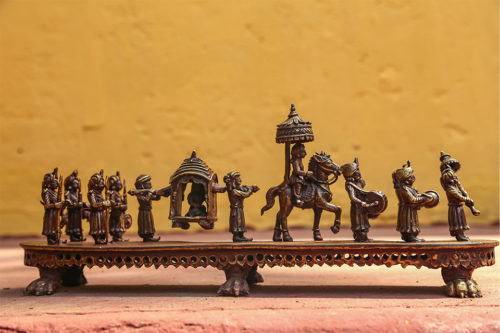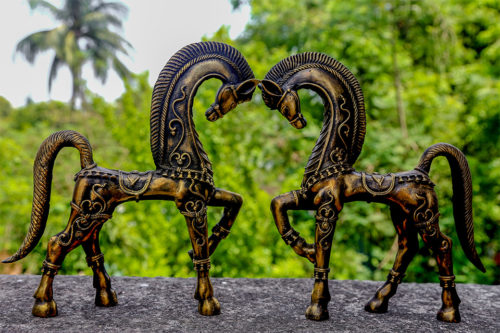Sukanta Banik
Proprietor, Dhamrai Metal Crafts
Dhamrai, the main center of metal casting in Bangladesh, is located about thirty-nine kilometers northwest of Dhaka, the capital city. A visitor to the quiet rural setting was once greeted by natural sounds and bustles of sounds, the clanging of metals, which made a wonderful rhythm of working melodies. This transpires the existence of metal crafts being an important part of Bengal’s rich artistic tradition that dates to before 2000 BCE on the Indian peninsula. History suggests that some of the greatest metal craft masterpieces of all times, made here by skilled artisans and sculptors, were magnificent in design, exclusivity of details, and workmanship. But over time, the cultural heritage, exceptionally rich in aesthetics and artistry, has fallen from its glory and only a few artisans are toiling to revive this millennium-old art form.

Pala Gohesh © Dhamrai Metal Crafts
Bangladesh was a land of mixed religion and culture in the past. For thousands of years, there was a large concentration of Hindus. Buddhism is still prevalent here in the hill tracts bordering Myanmar. After 1947, the Hindus’ exodus to India and the repetition of the same after the Bangladesh War of Independence in 1971 has left the community here a minority with a presence of below 10 percent of the total population.
Traditionally Hindus and in lesser proportion Buddhists were the main takers of this craft. They gave shape to their religious and social imaginations, beliefs, and messages through these artifacts: ranging from everyday use items to religious idols of both Buddhism and Hinduism. Dhamrai had been the epicenter of this traditional craft for centuries due to the quality, workmanship, and aesthetic appeal of the artifacts. In the early 1950s about thirty villages in the Dhamrai-Shimulia region were in this trade but now only around ten to twelve families, against all adversity, are trying their best to keep this tradition alive. Over and above, the aristocracy, who were once attached to using metal crafts, had in most instances faded out of the culture. These factors are at the roots of the craft’s dwindling market.
But as a kindle of hope, an organization named the Initiative for the Preservation of Dhamrai Metal Casting (IPDMC), headed by me, has taken up the task of reviving the lost glory of the metal crafts of Dhamrai. The craft started with the late Lal Mohan Banik, and the family has been in this trade for the last two hundred years. The Banik mansion in Rothkhola of Dhamrai, a century-old eye-catching palatial edifice, was once a primary supply point of metal crafts for other parts of the land. The family suffered huge losses during the Bangladesh liberation war, and their trade almost halted. Then with only five members left, I took over the receding family business in 2000. The rekindling journey of Dhamrai Metal Crafts (DMC), with me at the helm and with assistance from my uncle the late Shakhi Gopal Banik and my parents, Phani Bhushan and Tara Rani, began.
The craft has found its admirers in the diplomatic community and the foreigners who had been frequenting Dhamrai in search of metal artifacts and antiques. There is a wide market for oriental metal artifacts, especially of religious images in India, the USA, and Europe. Through these links, I met Matthew S. Friedman, an international health advisor with USAID. He had a keen interest in traditional arts. The relationship brought IPDMC an aid of US$14,300 under the US Ambassador’s Fund for Cultural Preservation (AFCP). Documenting the craft process, training of the artisans under skill exchange programs with Nepal, holding training workshops in Dhamrai, and having a workshop with two hundred school children in a bid to make them aware of their heritage were the activities undertaken with the fund. There were expositions at the Bengal Gallery of Fine Arts that drew many art lovers from home and abroad. The documentary on the craft was screened and acclaimed in Switzerland in 2007.

Wedding procession © Dhamrai Metal Crafts
At present, the artisans of Dhamrai Metal Crafts continue to produce lost wax castings using the same age-old method. They have been using a variety of different techniques to make metal objects of outstanding artistic brilliance. There are five different casting techniques practiced here: the lost wax method, the clay casting method, the sand casting method, the spoon casting method, and the plate casting method. Traditionally metals like copper, tin, zinc, iron, mercury, lead, gold, and silver are the primary raw materials used in the process. But as a rule, three basic alloys are mostly used here: brass, bell-metal or white brass, and bronze.
metal in the crucible melts, it is poured into the mold for the desired form. The mold is then cooled in open air before breaking it to bring out the metal figure that is then given finishing touches.
It is worth mentioning that the work of DMC is an exception regarding its variety, design, finish, and quality. While casting traditional objects using the ancient process, I have, at the same time, introduced contemporary sculptures with the amalgamation of different cultures. The delicate and masterly pieces highlight the creative ideas, extraordinary skill, highest precision, passion, dedication, and the time that is put in its making. At times, it takes a few months to complete a piece. The sensuality, spirituality, and beauty of these images appear as though they have been created for eternity and radiate a sense of immortality and mirror the enchantment and mystery of our ancient cultures.
The rich history of an undivided Bengal, tracing back to the Pala Dynasty (800-1100AD) when both early Buddhist and Hindu settlements flourished, is explicitly reflected in the metal artifacts made in Dhamrai. The DMC now is trying to revive the Pala art, an intricate style that develop during the Pala dynasty but went out of favor. The celebration of culture in all its richness inculcates a sense of pride in the diverse cultural scene and the traditions handed down through generations and develops a sense of appreciation for the traditional arts and crafts. But an indispensable element of Bangladesh’s heritage and artistic tradition, the centuries-old metal art of Dhamrai, is now on the verge of being lost forever. It is a collective responsibility to help revive and revitalize this rich art that forms an integral part of Bengal’s and well as the sub-continent’s identity. Economically, metal crafts add to the repertoire of non-traditional export items and is of significant value in the international market.

Dancing horses © Dhamrai Metal Crafts
In comparison to today’s mass-produced, machine-made uniform products, Dhamrai’s metal wares are marked by the uniqueness of every piece since they are purely handcrafted—a new and different mold is used for making every piece. The intricate designs and the spirit of every piece is the result of the creative intellect and artistic capability of the creative craftspeople—the more aesthetic value they add to their creations that satisfies the eyes and hearts of connoisseurs.
Among the metal workshops in Dhamrai, DMC has a distinct place for its variety, design, finishing, and quality. The works strike a balance in the production of metal statuary with religious fervor for the sacred, and profane or those for tourists. These delicate and eye-catching pieces highlight creative ideas, extraordinary skill, highest precision, passion, dedication, and the time that is put in their making. The sensuality, spirituality, and beauty of these images emphasize that as if they have been created for eternity that radiate a sense of immortality and reflect the fascination and mystery of our ancient cultures. It is due to the commendable effort of DMC that Bangladesh now is one of the few countries where this ancient tradition has been preserved in modern times.
The need of the hour is to take up the task of revival and conservation so that future generations can witness and appreciate the aesthetic values of these magnificent artworks. Preserving and safeguarding such cultural elements that timelessly reflect a region’s heritage is a necessity, as losing such traditions would be a loss for humanity. Apart from local initiatives, international bodies like UNESCO may assist to preserve and keep this legacy alive. There are several obstacles to sustaining the craft: scarcity of capital, absence of stability in the source and prices of raw materials, negligible market exposure, non-availability of institutional finance, and bureaucratic hassles for export initiatives. Generating social awareness—patronizing such form of art, publicity by the missions abroad, training and exposure of the artisans, ensuring the availability of raw materials, frequent expositions, both at home and abroad, product diversification, maintenance of standards, and product quality can be initiated to safeguard this tradition of humanity.
The artistic pieces pass through the ages, becoming part of the owner’s heritage and survives through generations. While accepting that metal art of Dhamrai is almost on the verge of fading out, one cannot ignore the fact that there is still a chance of reviving this rich heritage of Bangladesh. As the craft is a very ancient one, the artifacts tell the tale of past cultures, religion, and social structures. It can be an interesting subject for social scientists and archaeologists to study the social context of traditional metal casters. The craft bears religious, social, and ethnic values can be taken as topics for ethno-archaeological research into this art form. It would involve studying and analyzing contemporary cultures with the aim to understand the behavioral relationships that underlie the production of material culture and outline the role of metal crafts in the social evolution of the societies in this region.
Notes
| 1. | ↑ | Code letters assigned to the administrative divisions of the Maldives. |





